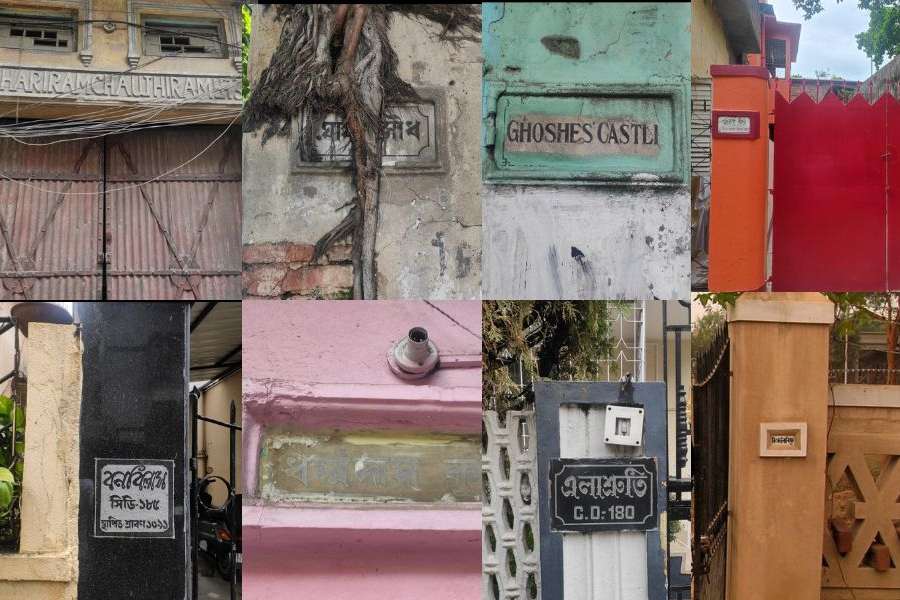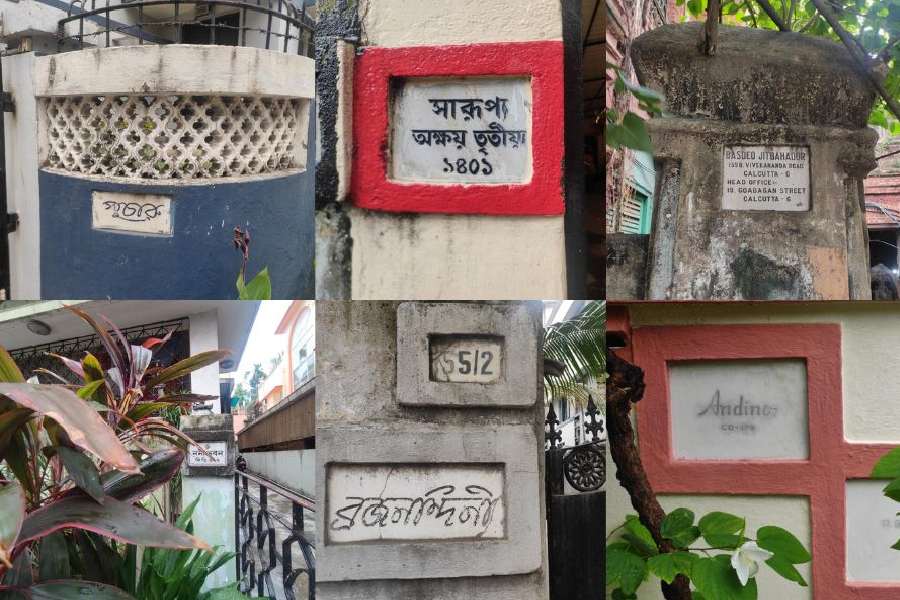On south Calcutta’s leafy Ballygunge Circular Road stands a three-storeyed house, carefully laid out with a garden and a mango tree, and a verdant name — Sucharu. The name etched on white marble at the entrance is a deliberate copy of the handwriting of Jibansu Mohan Gupta, who built the house in the 1970s. Says Paramita Gupta, who has lived here since she was married: “My father-in-law named it after his mother.”
Across Calcutta, in olden neighbourhoods one comes across such houses, atypical of their era in architecture, standing like sentinels of a vanishing civilisation. Their names veritablepasswords unlocking a wealth of backstories, summoning influences and philosophies and ideologies that melded with brick and mortar made a house, made a home.
Further down the same road as Sucharu is Brajanandini. It is the house where historian Barun De lived. Across the wall is its nameless identical twin. Says De’s daughter Urmila: “My paternal grandfather Basanta Kumar De along with his friend, a Mr Chakravarti, bought a 20 cottah plot from the erstwhile zamindar of Gouripur, Brajendra Kishore Raychaudhury.
The two friends built identical houses on the plot with an agreement that there would be no dividing wall between the two. Basanta Kumar named the house to honourhis parents Brajendranath and Nagendra Nandini.
The children and grandchildren of the two friends grew up together, played and raised a riot in the compound. “We would swing on the gates, jump across manholes, drag our rickety raths, hoist flags, and play cricket and badminton with friends joining in from St Lawrence, South Point, Patha Bhavana and Kamala Girls,” recalls Urmila.
The years rolled, legacy vows faded before exigencies. And when Brajanandini’s twin exchanged hands, the new occupants raised a wall.

Nameplates of houses in Calcutta.
More houses. More names. Walk down Gariahat, Fern Road and Ballygunge Gardens and you will come upon them — houses called Dhirendra Bithi, Prasanna Jyoti Smriti, Dharmadas Kutir, Golokdham, Nani Bhaban. Sometimes you have to peep through thefoliage or squint hard to be able to read the names.
Suman Ganguly’s house in Behala is called Kingkartabyabimudha, which according to Sansad dictionary means dumbstruck. Says Ganguly, “This house has caused me a lot of grief. I lost my wife, all of us who stayed in the house have dispersed and now I am waiting to sell it.” Ganguly, who worked as a marine engineer, couldn’t oversee the construction of it.
It was his wife who got the house built and had the name inscribed on a marble plate. “She received me at the airport when I returned and took me to see our house,” he recalls.
A consultant statistician, Mahua Sen’s house at Prantik in Santiniketan shares the name. She says, “After we built the house, many told us that the sandy soil at Prantik would cause our house to collapse. So we decided to call the house Kinkartabyabimudha, because we didn’t know what to do.”
Mahua’s grandmother had a penchant for naming all fond articles. Her spectacles were called Drishitinandan and her umbrella Malati. When Mahua bought a flat in north Calcutta’s Nagerbazar, she lived up to her genes, called her place Pratyutpannamati, meaning presenceof mind.
She has renovated and revived her maternal house in Bakulbagan and named it Abimrishyakarita, meaning “being injudicious”. “The house is a joint propertywith several owners and so when I decided to repair it, people told me I was being injudicious.”
Houses in north and central Calcutta are known for their heritage and grandeur. On the busy commercial thoroughfare that is Beleghata Main Road, right beside the sales tax office, is a gate. Beyond the gate, about 200 metres inside, is a dilapidated but magnificent house. On either side of the gate there is a nameplate. One reads Ghosh Castle and another, Ghosh Soudha. According to locals, one Balai-chandra Ghosh bought the plot in 1942. Further down that road, there are housing colonies named Gopi Kanan and Purbarag.
North of the city, Vivekananda Road yields a few gems. A bare red brick house bearing the name Basdeo Jitbahadur. Turns out, the property once belonged to the Gobardanga Rajbari.
Inside Haritaki Bagan Lane, on top of what looks like a garage gate, is a name etched in concrete — Behariramchauthiram — with the figures 19 and 35 on either side. The houses that line Haritaki Bagan Lane have names like Kshiroda Bhawan of 1370 BS, Tanu Bhawan, Uma House, presumably named after residents or residents’ ancestors.
Further down the wide avenue of Vivekananda Road, a number of tall, statuesque houses bear names like Deb Niwas. A building that serves as a ration office bears the name Amara. In a lane off Vivekananda Avenue is Dey’s House, which stands out because of the scroll on the nameplate. More houses, Radha-Kunja, Jashoda Kutir… A rather incongruous white mansion in a serpentine lane calls itself Murat Bungalow.
On to Central Avenue and there are these old four-storeyed houses with multiple tenants. Krishna Bhawan of 1937 vintage stands outbecause of its fresh paint. The lit-up Seth Soorajmall Jalan Balika Vidyalaya that has the lone Ram temple in the city is named after its erstwhile owner.
Names upon names, Ratnodham, Ashalota, Bonani, Probhat Pheri, Mayer Ashirbad, Krishna Villa, Snehochhaya, Teenkoridham, Chowdhury Nibash, Mayamoyee, Markat Kunjo, Katyaoni, Magnolia House, Victoria Garden, Elysium, Firdausi Manzil, Hyderi Haveli, Darul Ikhlas.
Salt Lake came to be populated in the 1950s and 60s when land reclamation was done to accommodatea growing population. Its plots were sold by lottery. Many a retired professional, central government and state government employees as well as doctors, lawyers, architects, finance professionals built their dream homes here.
One such house in a quiet lane of CD Block of Salt Lake bears the name Sarupya with the date Akshaya Tritiya 1401 (1994) inscribed below it. Turns out, its owner the late Sarbeshwar Jana had the grihapravesh on that auspicious day.
Jana’s daughter-in-law Kathakali loves the Sanskrit name. She says, “My father-in-law was a spiritual person and this was the only house that he built. He named it thus for he believed his abode was a reflection of the divine. Sarupya is a coming together of what he and my late mother-in-law Namita Jana wanted. It has large open spaces, lots of sunlight...”
Sarupya is a Sanskrit word that means “In His Image”.










